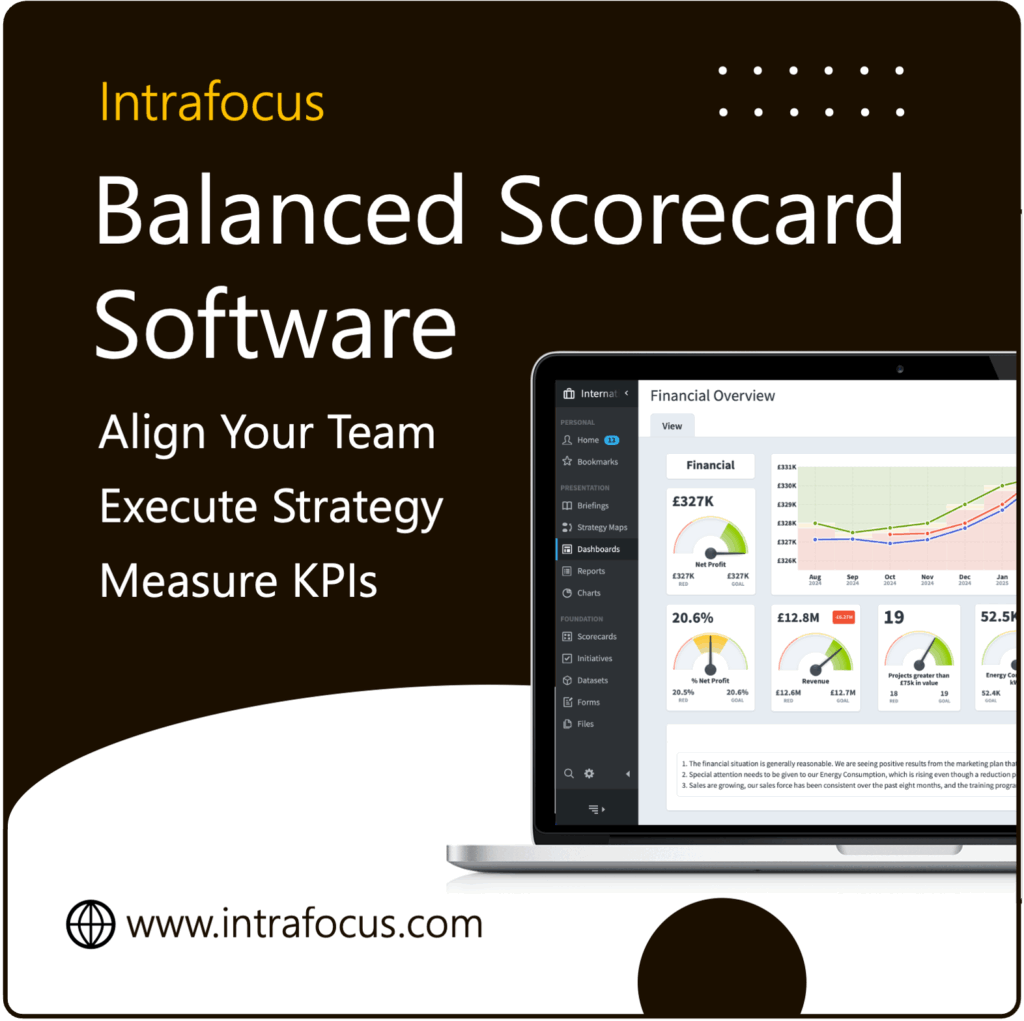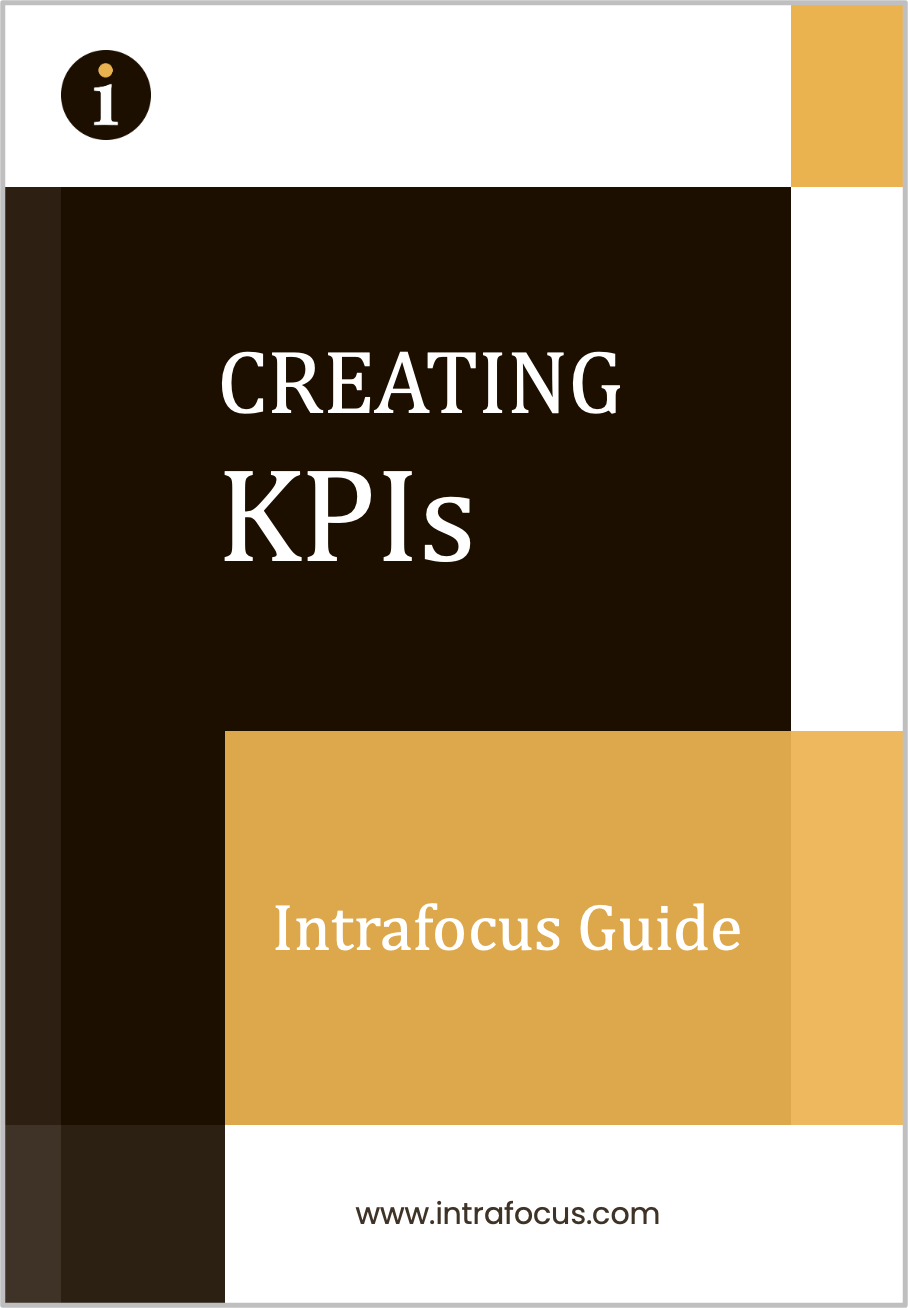Turning Ambition into Action
Strategic planning can be exciting in theory. Big ideas, bold ambitions, and the energy of setting a new direction. But that initial momentum fades quickly. Teams return to daily work, projects run in isolation, and the grand strategy becomes little more than a document on a shared drive.
Learn more: Balanced Scorecard software (EMEA) via Intrafocus — request a 30-day trial.
The problem isn’t usually the strategy itself. It lacks a clear, structured process to connect vision to daily action.
Intrafocus bridges that gap using the Seven-Step Strategic Planning Process (SPP). Built on the Balanced Scorecard framework, it provides a repeatable, disciplined way to move from ideas to measurable results.
Why You Need a Structured Strategic Planning Process
Many organisations use the “work it out as we go” approach to planning. While it feels flexible, it creates hidden costs, such as duplicated work, unclear ownership, wasted resources, and a growing disconnect between strategic goals and daily activity.
A structured process avoids these pitfalls by bringing consistency and focus to decision-making so everyone understands the priorities, the measures of success, and how their work contributes to the bigger picture.
This is where the Balanced Scorecard plays a crucial role. By looking at four perspectives: Financial, Customer, Internal Processes, and Organisational Capacity, leaders can ensure they balance short-term performance with long-term capability building.
The Intrafocus SPP takes this a step further. It doesn’t just define what to measure, it gives you a roadmap for creating the plan, implementing it, communicating it, and keeping it relevant through ongoing tracking and review.
We’ve seen organisations cut their planning time in half, dramatically improve KPI achievement, and create a shared sense of ownership simply by following this structure. Research from the Harvard Business Review on the importance of structured strategy execution highlights the role of clear processes in driving measurable success.
So, what are the Seven Steps?
Step 1. Foundation: Vision & Purpose
Every great plan starts with a clear foundation — your vision, mission, and core values.
- Vision: Where you want to be in the future
- Mission: Why you exist today
- Core values: Principles guiding decisions and behaviour
Without this clarity, strategy can drift. Leaders may prioritise different things, and teams may pull in opposite directions.
One healthcare provider refined its vague vision, “To deliver quality care,” into “To become the leading regional provider of integrated, patient-centred care by 2030.” This sharper aim anchored hiring, investment, and operational decisions.
Step 2. Assessment: SWOT, Value Proposition, Strategic Priorities
Once the foundation is clear, the next step is understanding your landscape. This involves:
- SWOT analysis: Assessing strengths, weaknesses, opportunities, and threats
- Value proposition: Defining what makes you unique and why customers choose you
- Strategic priorities: Identifying the three to five focus areas that will have the biggest impact
It’s all about perspective. Without it, you risk building a plan based on assumptions rather than reality.
For example, a manufacturer that excels at efficiency but struggles with after-sales support made “Improve customer support responsiveness” a priority, directing investment where it could differentiate.
Step 3. Strategic Objectives
With priorities in place, define your strategic objectives; high-level, measurable outcomes you want to achieve, aligning to the four Balanced Scorecard perspectives.
Avoid vague goals like “Improve efficiency” and aim for measurable clarity: “Reduce product cycle time by 15% within 12 months.”
A good strategic objective:
- Clearly states the outcome
- Includes a time frame
- Is linked to one or more priorities
This creates a direct line between your vision and the projects, KPIs, and initiatives that follow.
Step 4. Key Performance Indicators (KPI)
Decide how to measure progress with a few critical Key Performance Indicators (KPIs). Too many KPIS will dilute focus and overwhelm teams. Each KPI should have a clear owner, calculation method, and target value.
If your objective is “Reduce product cycle time by 15% within 12 months,” a KPI might be “Average days from product design to market launch,” tracked monthly.
For more guidance, see the Balanced Scorecard Institute’s KPI selection guide.
Step 5. Projects (Initiatives)
Projects (or initiatives) turn objectives into action. Each should have a clear scope, link to at least one objective, and measurable milestones.
If the goal is “Improve customer satisfaction by 10%,” a related project might be “Launch a 24/7 online support platform” with defined selection, training, and launch stages.
This step turns intentions into tangible work, ensuring that strategy drives activity, not the other way around.
Step 6. Communication
A strategy only works if people understand it. Communication should be ongoing, using leadership briefings, town halls, intranet updates, and dashboards.
The best organisations tell a consistent story about where they’re going and how they’ll get there. Leaders reference the strategy in decisions and recognise achievements linked to it.
Step 7. Automation (Software)
The final step is about keeping the strategy visible and manageable in real time. Using platforms like Spider Impact, organisations can track KPIs, monitor project progress, and share updates instantly across the business.
Automation ensures you work with the latest data and frees leaders from manually compiling reports. AI-powered features can highlight trends, forecast KPI performance, and trigger alerts when results fall outside expected ranges, enabling faster, more informed decision-making. For example, if customer satisfaction scores dip for two consecutive months, the system can automatically flag it, allowing managers to address issues before they escalate.
This step closes the loop, ensuring that strategy isn’t a static document but a living system that guides daily actions and adapts to change.
How the Steps Link Together
The SPP is designed to be followed in sequence, but its real strength is how it loops back on itself. Once you complete step seven, you’re not done. You’ve simply reached the point where measurement and learning feed back into step one.
This cycle keeps your strategy relevant. Regular reviews become opportunities to refine objectives, adjust priorities, and respond to change, not just a box-ticking exercise.
The result is a strategy that is alive, adaptive, and always moving forward.
Common Pitfalls and How to Avoid Them
Even with a proven process, it’s easy to fall into traps. A common one is skipping the assessment stage, leading to misaligned priorities and wasted effort.
Another is overcomplicating the Balanced Scorecard with too many measures, which dilutes focus. The BSC should highlight only the critical metrics that drive performance.
A third is treating communication as a one-off event. Keeping strategy alive requires an ongoing conversation where people see progress, understand changes, and feel connected to the bigger picture.
Intrafocus helps organisations avoid these pitfalls through a disciplined, collaborative process supported by the right tools.
A Real-World Transformation
A mid-sized technology company came to us with a familiar challenge: strong leadership and ambitious goals, but scattered, reactive projects.
We used the SPP to sharpen their vision, set three strategic priorities, and create a Balanced Scorecard aligning objectives, KPIs, and initiatives across all four perspectives.
With Spider Impact dashboards, managers had real-time visibility, and leadership meetings shifted from status updates to performance discussions.
Within 12 months, product release cycles were 18% faster, customer satisfaction rose by 12 points, and operating margins improved. More importantly, teams felt connected to the strategy and their role in delivering it.
Strategic Clarity
A clear vision is important, but it’s not enough. Without a structured process, even the most inspiring strategy risks fading into background noise. The Seven-Step Strategic Planning Process gives leaders a practical way to move from ambition to measurable action, ensuring every decision and initiative is anchored in the bigger picture.
By linking the Balanced Scorecard framework to a repeatable planning cycle, the SPP brings both focus and flexibility. You get the discipline needed to keep priorities on track, and the agility to adapt when circumstances change.
If you’re ready to move from disconnected projects to a unified strategy system, Intrafocus can help. Our consultancy services, combined with the power of Spider Impact, make it easy to build, communicate, and manage your strategy in real time.
Contact us today to see how we can help you bring your strategy to life — and keep it alive.



